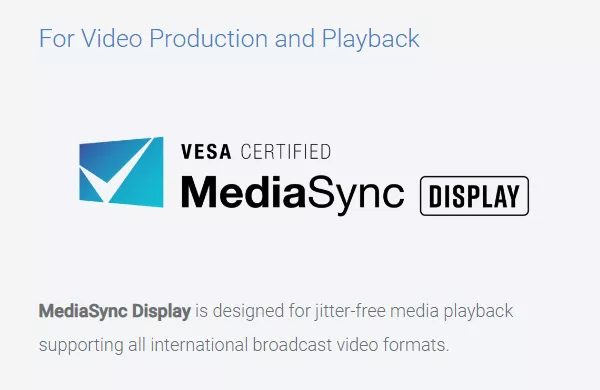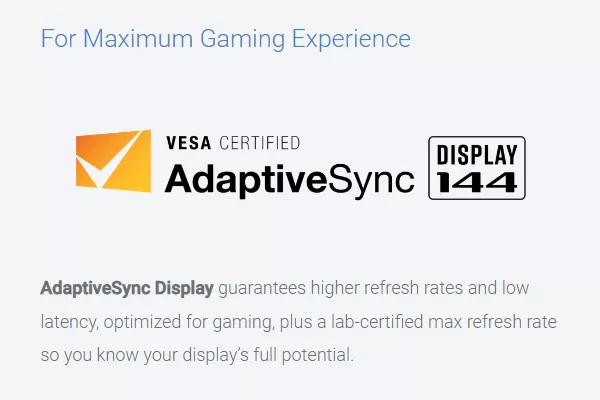The Video Electronics Standards Association (VESA) has just expanded its certification program for "variable refresh rate" (VRR) displays to help consumers easily purchase such products Unlike the previous "high dynamic range" (HDR) certification project, which measures indicators such as peak brightness, the new "adaptive sync display CTS" certification project focuses on variable refresh rate displays, which can prevent flickering, tearing, frame loss and other phenomena.

(Figure via MSI)
For the majority of PC gamers, the first contact with VRR technology is on specific graphics card / display products - including NVIDIA led closed-source g-sync and amd mainly promotes the open source freesync scheme.
In 2014, VESA and AMD provided native support for "adaptive sync" in the DisplayPort 1.2A standard. Now, the standard has been fully accepted by AMD, NVIDIA and Intel.
At the same time, a / N has been competing to promote its own "variable refresh rate" (VRR) authentication scheme for a long time, but its influence is relatively limited. For example, when NVIDIA launched the "g-sync compatibility" certification project in 2019, the passing rate was only 5.56%.
The brushed products either do not provide a wide enough refresh rate range, or there are other image quality problems (such as flickering).

VESA adaptivesync display CTS member list
The latest news is that VESA is testing the prototype performance of adaptive sync. Its biggest feature is that it is not specific to GPU support like freesync or g-sync, so it is expected to attract more OEM manufacturers to join.
More importantly, VESA's adaptive synchronization technology is based on the DisplayPort standard - suitable for computers, displays, and usb-c video output - rather than specific to [TV] as the VRR scheme based on HDMI 2.1 standard( ?site_id=242986&euid=&t=https%3A%2F%2Flist.jd.com%2Flist.html%3Fcat%3D737%2C794%2C798%26ev%3D4155_76344%26sort%3Dsort_rank_asc%26trans%3D1%26JL%3D2_1_0%23J_crumbsBar ) Equipment.
Roland Wooster, Intel engineer and chairman of VESA task force, pointed out that in addition to being more open, VESA's new certification project will also help promote display device manufacturers to deliver higher specification products to consumers.
Although they have seen that some monitors have passed the tests of sub projects such as flicker and jitter, it is expected that less than half of the adaptive synchronous displays on the market can meet the standards of VESA (similar to the situation in the early promotion of NVIDIA g-sync).

(from: adaptivesync.org official website)
To get back to business, VESA's new certification includes adaptive sync and mediasync. The latter is suitable for content creation and video viewing, while the former is more suitable for E-sports games.
Certified manufacturers can use relevant logos in equipment packaging, websites and any other places that may attract potential consumers. Products that fail to pass the certification will not be allowed to use. (in order to save face, the failed models will not be publicly disclosed)
Specifically, mediasync certification aims to ensure that the display meets 10 major international frame rate standards - including 23.976 (common in the U.S. / movie content), 24, 25, 29.97, 30, 47.952, 48, 50, 59.94, and 60 FPS.
Although it seems simple, when playing on a 60Hz display, 24 fps content with non integer magnification may encounter some problems. The commonly used "3:2 pull-down" scheme (make a frame appear twice in turn), but doing so will produce unpleasant jitter, which mediasync can easily resolve.

Then there is the adaptive sync certification mainly for high screen swiping E-sports displays. VESA requires that the product must support a high refresh rate of @ at least 144hz at the original resolution by default.
As for the lower limit, it is relatively loosely maintained at 60Hz. Wooster explained that if the frame rate drops to a lower level (such as 58 FPS), the display is expected to double to an integer (116 FPS) adaptive synchronization state.
In addition, taking the nominal 144hz display as an example, the certified model can add a small box of "display 144" on the right side of the certification logo to reflect the maximum refresh rate it supports in the original resolution state (whether 144, 240 or 360 Hz).
